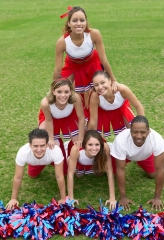High school cheerleaders don't get injured as often as athletes in other sports, but, when they do, the injuries are more serious, finds a first-of-its-kind study published in the journal Pediatrics.
Analyzing data from 2009 to 2014, researchers found that cheerleading ranks 18th out of 22 high school sports studied in terms of injury rate, but, ranked second - behind only gymnastics - in the proportion of injuries that resulted in an athlete being benched for at least three weeks or for the entire season.
The study was the first to comple injury rates and patterns in high school cheerleading, compare injury rates and patterns by type of exposure (i.e. practice, competition, or performance), and compare injury rates and patterns in high school cheerleading to other sports using the High School Reporting Information Online (RIO), an Internet-based high school sports injury surveillance system begun in the 2005/2006 academic yeare, and expanded in 2009/2010 to include 13 additional sports, bringing the total to 22., but unlike the original 9 sports, nationally representative samples could not be recruited due to geographic variability in popularity of some sports, so a so-called 'convenience' sample was used.
Another limitation was that it did not account for variation in the type of stunts or activities being performed. As as a result of being unable to classify exposure on type of activity, researchers could not say whether squads were more competitive or elite so as to determine whether they had different injury rates than less competitive squads who perform more of a traditional "spirit" role supporting other sports teams.
Unusal injury pattern
Researchers found that more injuries occurred during cheerleading competition and practice (.85 and .76 injuries per 1,000 athlete-exposures respectively), than during performances (.49 injuries per 1,000 exposures).
The "finding that practice and competition injury rates were similar makes cheerleading unusual compared with other high school sports," Currie noted, "where injury rates tend to be significantly higher in competition than practice," and "may be due to the similarity in activities between practice and competition in cheerleading (i.e. learning and performing stunts or maneuvers), as compared with sports like ice hockey and football, where much less player-player contact is initiated in practice than in competition, leading to fewer injuries."Higher proportion of injuries are concussions
The study found that concussions were the most common injury, accounting for three in ten of all cheerleading injuries (followed by ligament sprains, muscle strains and fractures), but that concussion rates were significantly lower in cheerleading (2.2 per 10,000 athlete-exposures) than all other high school sports combined (3.8 per 10,000 exposures) and all other girls' sports combined (2.7 per 10,000 exposures).
Seven in ten (69%) of all concussions occurred during stunts (consistent with prior studies), with pyramid formations accounting for 16 percent and tumbling representing 9 percent.
Concussions accounted for 31% of all cheerleading injuries - a dramatically higher percentage than reported in previous studies, which ranged from 4% to 6% - and likely a reflection of the increased concussion rates seen in other high school sports over the same period, and "possibly due to increased awareness and changes in diagnostic criteria over the past decade," Currie said.

Cheerleaders at base: most at risk
Cheerleaders at the base of formations for stunts and pyramids accounted for 46 percent of all injuries, followed by flyers (36 percent) and spotters (10 percent).
Taken together with an earlier study finding injuries to cheerleaders in the basing/spotting position most common, the researchers said that "bases are at particular risk of injury from contact with another athlete during stunts," and that "[f]uture research should focus on identifying ways to better protect bases during stunts."
Safety improving
The study noted that the request by the National Federation of State High School Associations (NFHS) to request inclusion of spirit/cheerleading in the High School Reporting Information Online (RIO), an Internet-based high school sports injury surveillance system, the NFHS Spirit Rules Book, a valuable resource for high school coaches updated annually, and the Cheerleading Safety Manual and Spirit Safety Certifications for coaches offered by the Association of Cheerleading Coaches and Administrators in collaboration with the NFHS were all "positive steps ... to improve cheerleading safety."
"Associations governing cheerleading have recognized the need to be proactive in driving evidence-based changes relating to the safety of cheerleaders," Currie observed.
Our "in-depth look at high school cheerleading epidemiology provides further evidence that can be used to inform policymakers, parents, coaches, ATs, and athletes regarding injury risks and potential [prevention] strategies," he concluded.
Sources:
American Academy of Pediatrics
Currie DW, Fields SK, Patterson MJ, Comstock RD. Cheerleading Injuries in United States High Schools. Pediatrics 2016;137(1): e20152447 (epublished ahead of print December 9, 2015).








